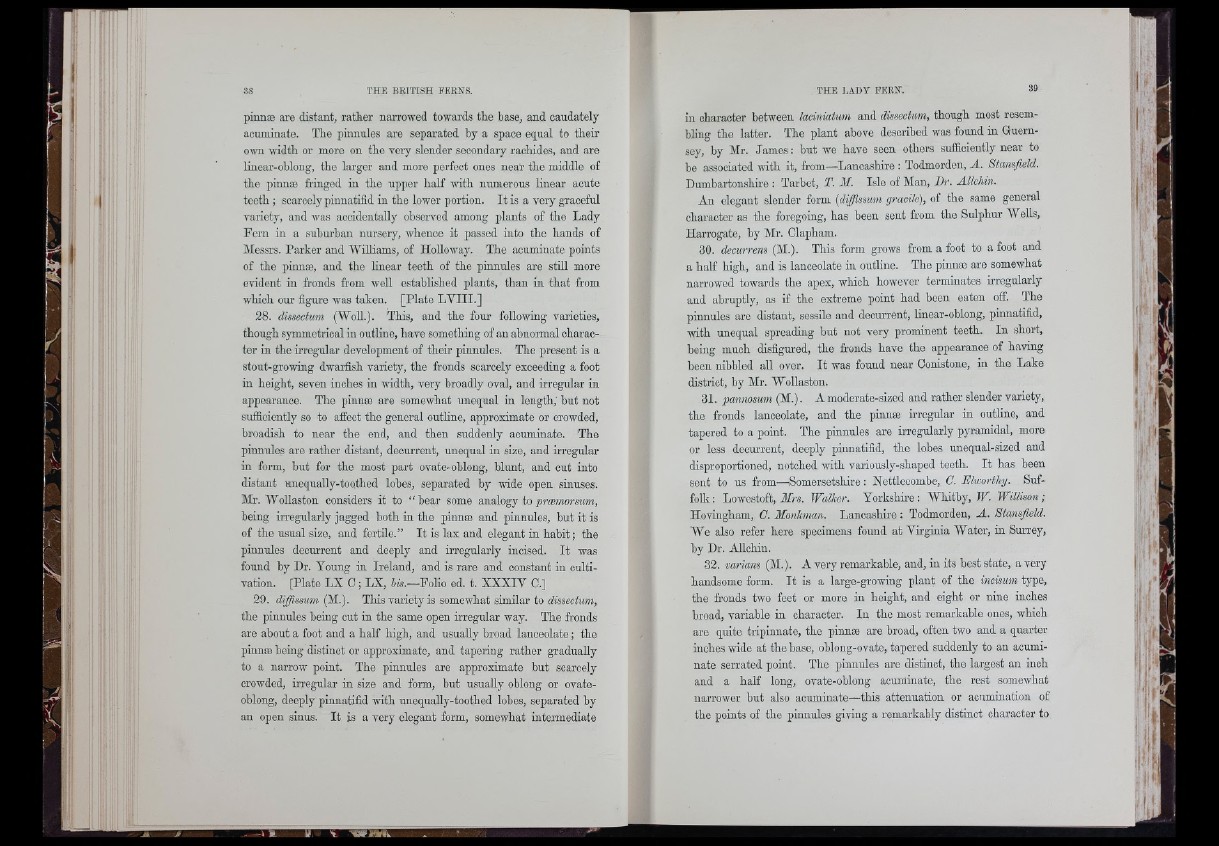
risi
pinnæ are distant, rather narrowed towards the base, and caudately
acuminate. The pinnules are separated by a space equal to their
own width or more on the very slender secondary rachides, and are
linear-ohlong, the larger and more perfect ones near the middle of
the pinnæ fringed in the upper half with numerous linear acute
teeth ; scarcely pinnatifid in the lower portion. It is a very graceful
variety, and was acoidentaUy observed among plants of the Lady
Fern in a suburban nursery, whence it passed into the hands of
Messrs. Parker and WiUiams, of Holloway. The acuminate points
of the pinnæ, and the linear teeth of the pinnules are stiU more
evident in fronds from well established plants, than in that from
which our figure was taken. [Plato LVIII.]
28. dissectum (WoH.). This, and the four following varieties,
though symmetrical in outline, have something of an abnormal character
in the irregular development of their pinnules. The present is a
stout-growing dwarfish variety, the fronds scarcely exceeding a foot
in height, seven inches in width, very broadly oval, and irregular in
appearance. The pinnæ are somewhat unequal in length; hut not
sufiioiently so to afibot the general outline, approximate or crowded,
broadish to near the end, and then suddenly acuminate. The
pinnules are rather distant, decurrent, unequal in size, and irregular
in form, but for the most part ovate-oblong, blunt, and cut into
distant unequally-toothed lobes, separated by wide open sinuses.
Mr. Wollaston considers it to “ bear some analogy to præmorsum,
being irregularly jagged both in the pinnæ and pinnules, but it is
of the usual size, and fertile.” It is lax and elegant in habit ; the
pinnules decurrent and deeply and irregularly incised. It was
found by Dr. Young in Ireland, and is rare and constant in cultivation.
[Plate LX 0 ; LX, bis.—Folio ed. t. XXXIV C.]
29. diffissum QsL). This variety is somewhat similar to ¿¡ssectiim,
the pinnules being cut in the same open irregular way. The fronds
are about a foot and a half high, and usually broad lanceolate ; the
pinnæ being distinct or approximate, and tapering rather gradually
to a narrow point. The pinnules are approximate but scarcely
crowded, irregular in size and form, but usually oblong or ovate-
oblong, deeply pinnatifid with unequally-toothed lobes, separated by
an open sinus. It is a very elegant form, somewhat intermediate
in character between laciniatum and dissectum, though most resem-
bhng the latter. The plant above described was found in Guernsey,
by Mr. James : but we have seen others sufficiently near to
he associated with it, from—^Lancashire : Todmorden, A. Stansfleld.
Dumbartonshire : Tarbet, T. M. Isle of Man, Dr. Allchin.
An elegant slender form {difflssum gracile), of the same general
character as the foregoing, has been sent from the Sulphur Wells,
Harrogate, by Mr. Clapham.
30. decurrens (M.). This form grows from a foot to a foot and
a half high, and is lanceolate in outline. The pinnæ are somewhat
narrowed towards the apex, which however terminates irregularly
and abruptly, as if the extreme point had been eaten off. The
pinnules are distant, sessile and decurrent, linear-oblong, pinnatifid,
with unequal spreading but not very prominent teeth. In short,
being much disfigured, the fronds have the appearance of having
been nibbled all over. It was found near Conistone, in the Lake
district, by Mr. Wollaston.
31. pannosum (M.). A moderate-sized and rather slender variety,
the fronds lanceolate, and the pinnæ irregular in outline, and
tapered to a point. The pinnules are irregularly pyramidal, more
or loss deourrent, deeply pinnatifid, the lobes unequal-sized and
disproportloned, notched with variously-shaped teeth. It has been
sent to us from—^Somersotsbire : Nettlecombe, G. Elworthy. Suffolk:
Lowestoft, Jfrs. Walker. Yorkshire: Whitby, W. Willison ;
Hovingbam, 0. Monhnan. Lancashire : Todmorden, A . Stansfleld.
Wo also refer here specimens found at Virginia Water, in Surrey,
by Dr. Allchin.
32. varians (M.). A very remarkable, and, in its best state, a very
handsome form. It is a large-growing plant of the incisum type,
the fronds two feet or more in height, and eight or nine inches
broad, variable in character. In the most remarkable ones, which
are quite tripinnate, the pinnæ are broad, often two and a quarter
inohes wide at the base, oblong-ovate, tapered suddenly to an acuminate
serrated point. The pinnules are distinct, the largest an inch
and a half long, ovate-oblong acuminate, the rest somewhat
narrower but also acuminate—tbis attenuation or aoumination of
tbe points of the pinnules giving a remarkably distmot character to
I :
. i'l
I :
I i
I . 1 I
’ ’I
m